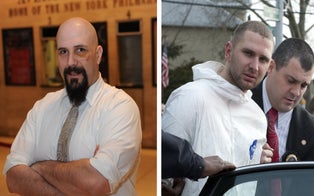Using a plastic license plate cover allows for a plate to be read head on but when viewed from an angle, the characters disappear.
While tolls help pay for bridges and roads and red light and speeding cameras keep our streets safer, an Inside Edition investigation has found some members of law enforcement illegally covering up their license plates.
The Inside Edition probe found more than 100 vehicles parked near New York City courthouses and police precincts with plastic license plate covers that allow for a plate to be read straight on, but when viewed from an angle, the characters on the plate become obscured and would not be able to be read by red light or toll cameras.
All of the vehicles were adorned with placards indicating they were the personal vehicles of members of law enforcement.
The placard on one dashboard said the driver was with the New York City Police Department. When he returned to his car, Inside Edition’s Chief Investigative Correspondent Lisa Guerrero spoke to him.
“Are you trying to avoid paying tolls and paying tickets by having those covers on your license plate?” Guerrero asked the officer.
"No," he replied.
“Then why would you put them on there?” she asked.
He was apparently so embarrassed that he decided to remove the plate covers right in front of our cameras with a screwdriver Guerrero loaned him.
“I just noticed that you have plastic covers on your license plate. Does that allow to skip paying tolls?” she asked an NYPD officer as he tried to drive away.
“No it does not,” he replied.
A third driver with plastic covers on his plates wouldn’t even roll down the window of his car.
Inside Edition also found an SUV with a dashboard placard indicated that the driver was a federal officer. His car had its front license plate removed and the rear plate was covered by one of those plastic covers. The driver wouldn’t answer Guerrero’s questions about his illegal plate configuration.
And New York City is not alone; Inside Edition found law enforcement employees hiding their plates in Philadelphia as well.
Many Philadelphia Police Department officers use tinted covers while others preferred to hide their plate by affixing a police union badge right over the digits on the plate.
Guerrero asked one such driver about the badge concealing his plate: “Can I ask you about your license plate over here?”
“No thanks,” he said, as he closed his door and drove off.
One SUV had a plate cover so obscured with tint, you could barely see it.
Again, the driver, who’s placard indicated she was a member of the Philadelphia Police Department, refused to answer Guerrero’s questions.
In a statement to Inside Edition, The Philadelphia Police Department said, “Officers must abide by all laws of the commonwealth, the same as any other citizen, which includes vehicle codes. If an officer has something obstructing the view of the license plate, then they can be cited just as any other citizen would be. This is not tolerated by the department."
The New York Police Department also responded to the Inside Edition investigation, saying, “This is an issue the Department has been aware of and is working to address. The Department has instructed precinct commanders to ensure officers in their commands are complying with traffic laws and internal guidelines on license plate covers. Just this week, there were several spot inspections in lower Manhattan to ensure personal vehicles of police officers are following traffic laws.





